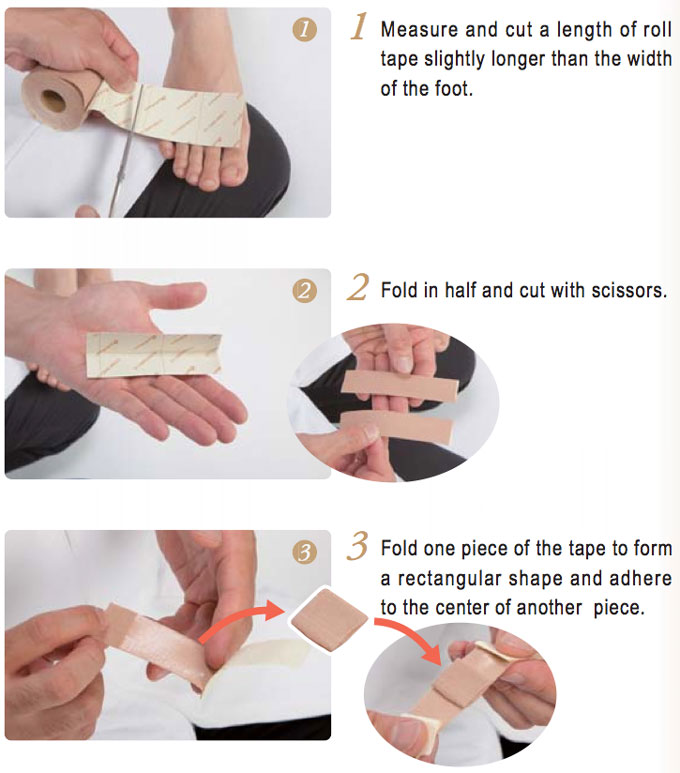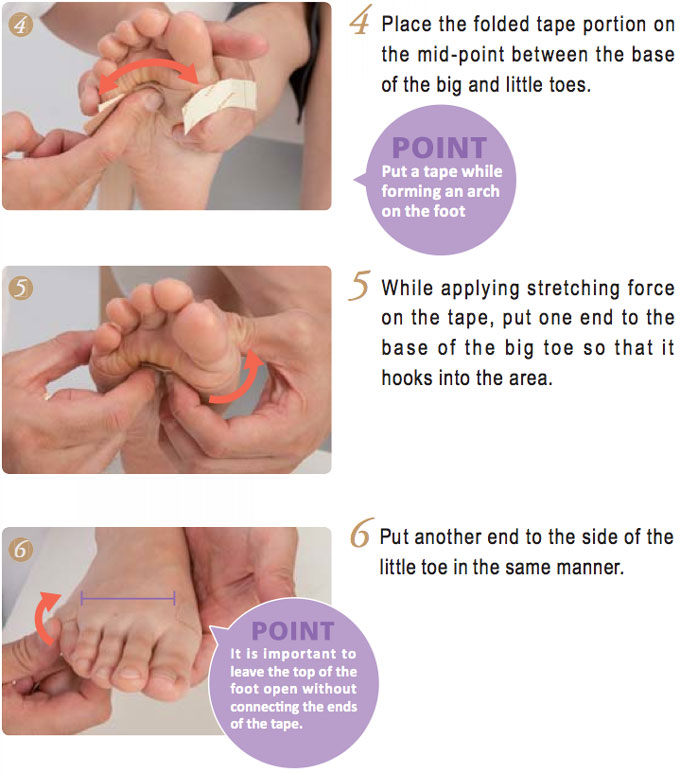Metatarsal Massage
Metatarsal massage can save modern people from foot fatigue.
From the general public to athletes, the landmark "metatarsal massage", developed by Phiten's therapeutist Chino Toru, responds to foot troubles. Saving modern people's feet in just 3 minutes a day!
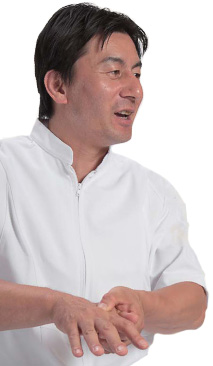
Chino Toru
Phiten therapeutist
- Judo therapist
- Chinese dietician
- Supplement advisor
Effects of metatarsal massage
- Allows for the "transversearch" of the foot recover and distributes impact from the bottom of the feet!
- Relaxes its inner muscles, and relieves foot fatigue from within!
- Relieves flat feet and hallux valgus concerns
The surprising effects of foot "metatarsal massage", not just for building beautiful arches.
Over long years as a therapeutist at Phiten, I have examined a truly large number of people suffering from "flat feet" and "hallux valgus". What I came up with in an effort to help these people suffering from these troubles was to restore a clean arch to the foot by strengthening the "adductor hallucis muscle" and "metatarsal" through massage. While this method made a lot of patients happy, surprisingly, many of them also stated "it made our entire foot more comfortable and relaxed". I personally also found this surprising and went back to my anatomy books to study fur ther. They showed me that the "metatarsal" is actually connected to a variety of muscles all over the foot, so massaging the metatarsal it essentially massages deeper muscles in the foot where conventional massage cannot reach.
Resolving modern people's foot troubles including general foot fatigue, flat feet and hallux valgus, in just 3 minutes.
This massage method has been established as the landmark "metatarsal massage", which can relieve foot fatigue and help prevent feet from becoming fatigued by recovering a clean arch on the sole of the foot. We cannot unveil their names here, but I have resolved the foot troubles of a number of long-distance runners and famous athletes by this massage method. I really take pride in this "metatarsal massage", which can be implemented easily by anyone in just 3 minutes, It is truly groundbreaking method for both the massage and sports industries. If you suffer from foot problems, use this massage to bring relaxation. Now I'd like to introduce the mechanisms of the "metatarsal massage" in more detail.
Flexibility of the sole of the foot is the key to good health
Restore the "arch" to your foot to make it more fatigue resistant.
The cause of "quick onset fatigue" and "swelling" may be absence of "arches"!
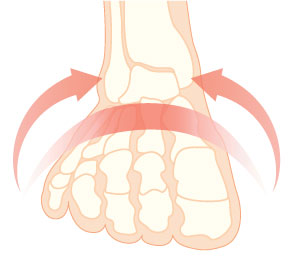
Fatigue resistant feet with "arches"
The "arch" absorbs and disperses impact from the bottom of the foot, and eases the stress on the foot.
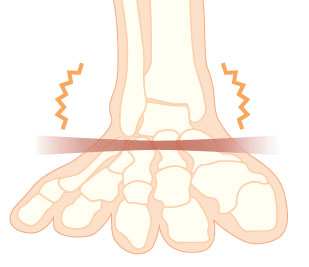
Flat feet (feet without "arches")
Impact from the bottom of the foot directly spreads throughout the foot. This can be the cause of swelling, coldness and other bad conditions.
Arch disperses impact. A flexible sole supports good health.
The "sole" of the foot is actually an extremely important location affecting our entire bodies including the knees and hip. The bones of the foot consist of separate, long, slender bones connected by ligaments, and they form an "arch". This "arch" is extremely important for movement, and if the "arch" is not present, impact directly spreads to and is accumulated in the ankles, knees and hip. In addition, when we walk or run, we unconsciously move our center of gravity with the soles of our feet to maintain balance, however, this is also only possible thanks to a flexible sole. Lack of this flexibility can result in stumbling more often or a feeling of instability when standing, and more caution is required. A flexible "arch" also serves as a shock-absorbing cushion during sports activity, supporting nimbler movement.
Strengthen the adductor hallucis muscle and metatarsal ligament to regain arches.
The "transverse arch" handled in this approach is essentially supported by the "adductor hallucis muscle" and "metatarsal ligament", however, modern people comparatively walk less in bare feet and also exercise less, resulting in a weakening of the "adductor hallucis muscle". This results in more concentration of load sorely on the "metatarsal ligament", which causes it to always be in a fully stretched out position. It seems that this is the transition in which the "arch" has gradually been lost from the feet of the modern people. The "metatarsal massage" therefore restores flexibility and strengthens the "adductor hallucis muscle" and "metatarsal ligament" by stretching them. Restoring the original arch to the foot eases concerns arising from "flat feet" and "hallux valgus". In addition, the arch now serves to disperse impact on the feet, leading them to more fatigue resistant feet.

"Hallux valgus” and "Digitus minimus varus”
A condition where the metatarsal spreads out and the toes face inwards.

Correct "arch" condition
The arch is supported by the "adductor hallucis muscle" and "metatarsal ligament"
Surprising results in just 3 minutes
Moving the metatarsal to relieve fatigue from inside of the foot.
Hardening of musculature from fatigue causes sway in foot movement.
Another effect of the "metatarsal massage" that deserves attention is that it allows for softening inner muscles on the inside of the feet, which weren't possible to massage by hand up until this technique. The "metatarsal" we are focusing on here is actually connected to a number of the muscles in the feet, including the peroneus longus, peroneus brevis, tibialis anterior and tibialis posterior. Fatigue builds up in these muscles extremely easily, and once it builds up, the flexibility of the muscle is lost and the muscle hardens. When trying to soften these muscles where fatigue has built up, even if a surface massage is performed on a foot surface, the muscles inside of the foot are hardly relaxed. Even if a greater amount of time is spent to massage and soften the interior muscles, there is a limit on how much this can be achieved, and we would have to say that the benefits would be minimal. However, with this "metatarsal massage", focusing on moving the "metatarsal", it is possible to cause For example, cases where the "peroneus longus" muscle in the rear exterior of the foot becomes fatigued and hardens in runners. When this happens and the afflicted individual runs, the exterior muscles do not stretch , so the ankle does not move straight, causing sway in the movement. This sway in the movement of the ankle is unsafe and often the cause of sprains and other injuries. In addition, it is said that if these muscles are not looked after, fatigue will continue to accumulate, so everyday care is extremely important.
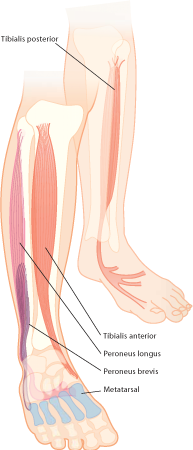
Stretch inner muscles by moving the metatarsal.
When trying to soften these muscles where fatigue has built up, even if a surface massage is performed on a foot surface, the muscles inside of the foot are hardly relaxed. Even if a greater amount of time is spent to massage and soften the interior muscles, there is a limit on how much this can be achieved, and we would have to say that the benefits would be minimal. However, with this "metatarsal massage", focusing on moving the "metatarsal", it is possible to cause each of the muscles to extend and contract. This allows for stretching of and a massaging effect on the inner muscles, which were hardly reached by hand up until now. This allows for a surprising massage effect in just 3 minutes which was previously not achievable with external massage even if 30 minutes were spent for it. The "metatarsal massage" is a truly landmark massage technique that relieves fatigue built up in inside of the feet in just 3 minutes, and helps restore the arch of the foot for more fatigue-resistant feet.
Change your feet in just 3 Minutes!
Build the arch and soften feet from inside.
Firmly moving the metatarsal helps restore flexibility to the"adduct or hallucis muscle" and "metatarsal ligament", and restore a clean arch to the sole of the foot. This massage also provides massage benefits to the unreachable inner muscles, relieving stress from the entire foot from inside. This massage is great not only for physically active people, but it is worth a try for anyone who feel foot fatigue.
Building a foot with a clean arch by simple taping method
Reinforce the“arch” and build up feet better suiting for walking.
The metatarsal can be securely supported using Phiten's flexible roll tape. Taping technique helps to build the arch and provides backup support for the metatarsal when walking.
